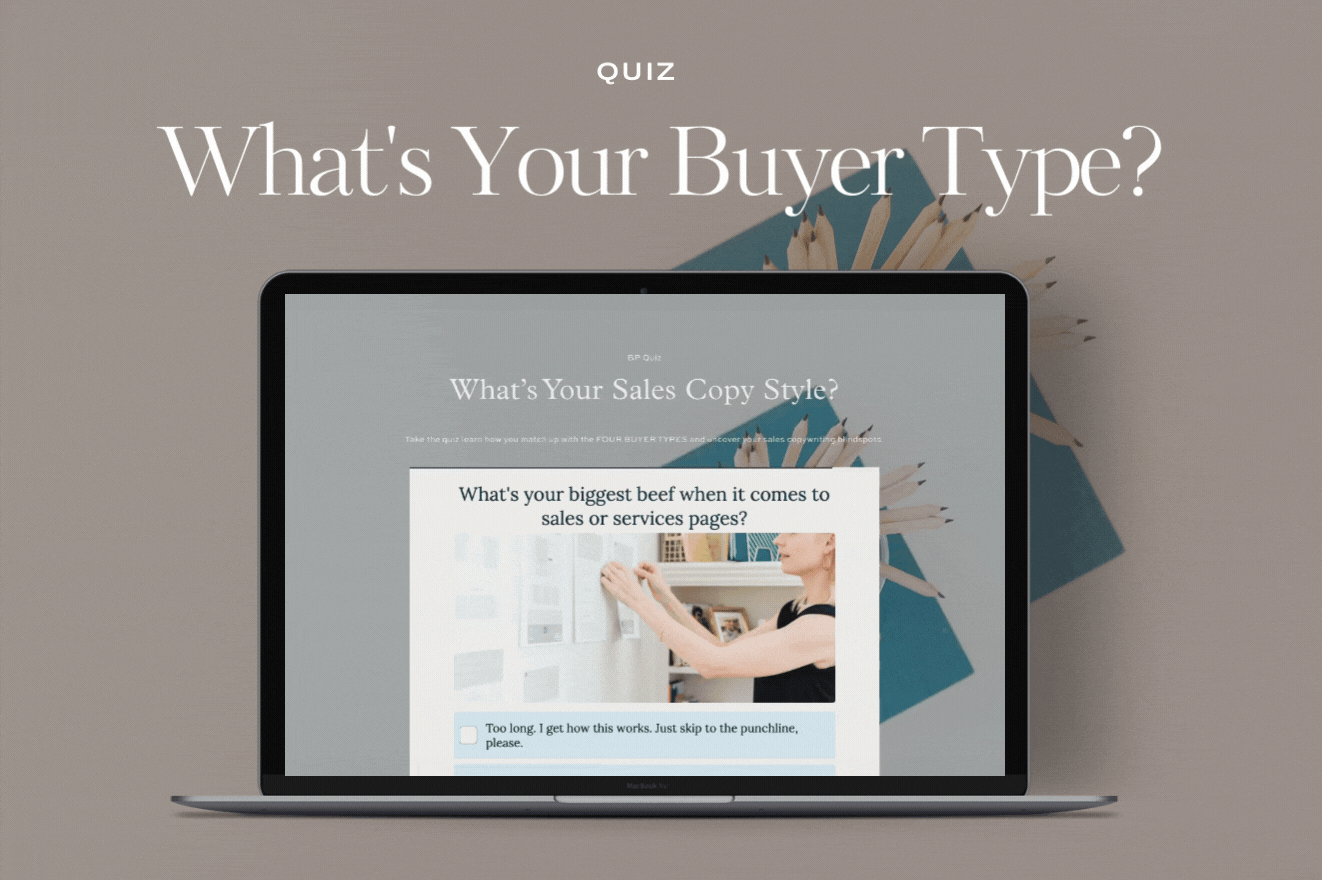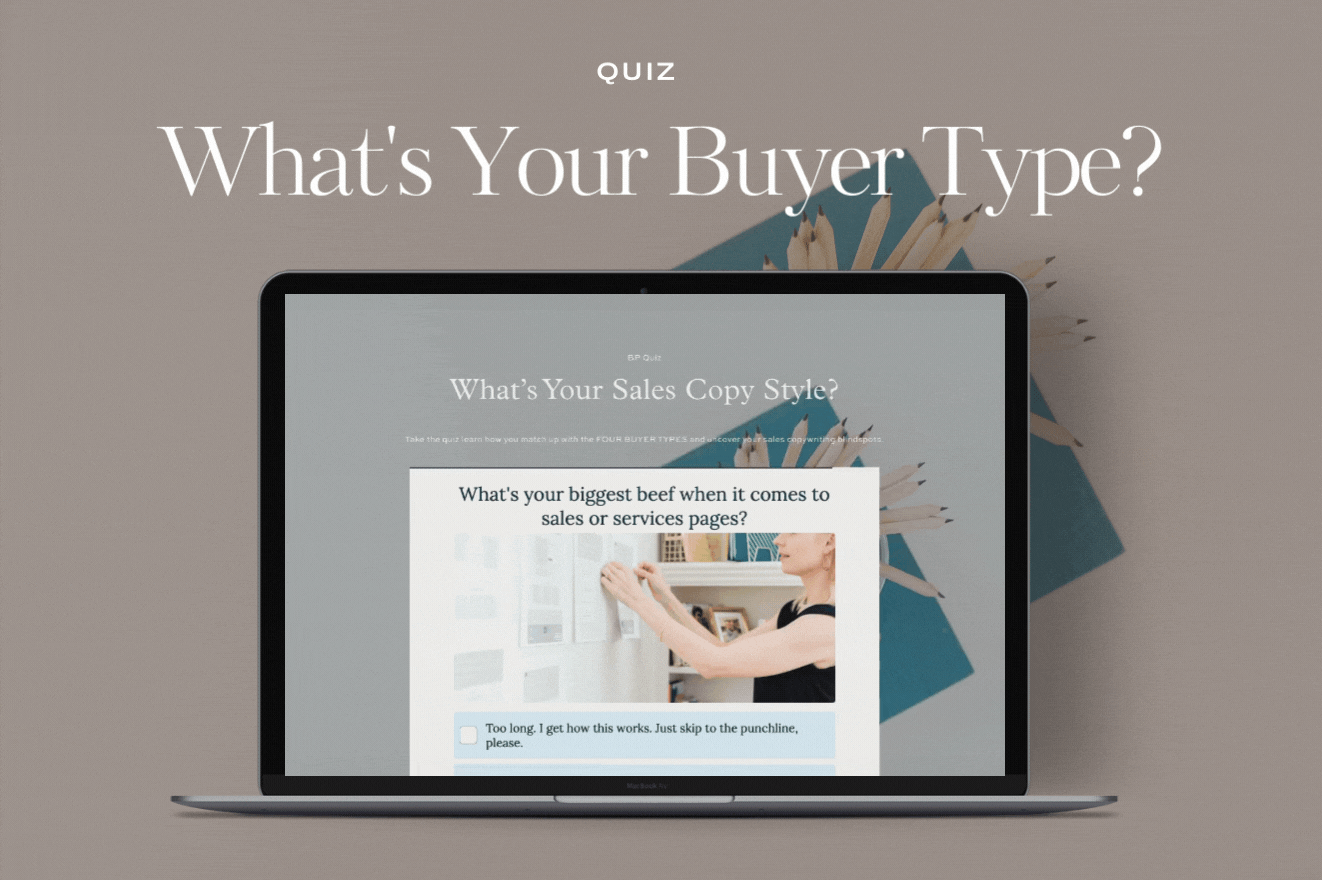When I first started writing website copy and sales copy, I knew my job was to be as persuasive as possible. But persuasive to whom?
One of the first exercises I walk my clients through during a Brand Strategy + Website Copy project is deconstructing their audience personas to figure out their brand messaging points. All of the copy from this point on centers around this messaging, providing guardrails to keep all of our copy focused on our audience.
Great, right? Actually… there’s another level to the art of the sale.
What are the four buyer types?
The 4 Buyer Types are a way of profiling your entire audience and identifying how your warmed-up leads like to be sold to based on their internal buying psychology.
You can think of buying psychology as an invisible checklist of wants, needs, and proof your reader needs to see written out on the page before feeling confident enough to pull out their credit card and make a purchase.
The four types are: THE SOCIALIZER, THE DIRECTOR, THE RELATOR, and THE THINKER.
How can you use the four buyer types to write compelling sales copy?
When you understand the cues each type of buyer is looking for as they scroll the page you can start to layer in compelling copywriting (this is called a “copy sweep”) that appeals to each type’s buying triggers.
After all, most people come to your website or landing page with a different set of experiences and expectations that affect their buying decisions.
✍️ Your job is to convincingly appeal to all of them.
What cues are the four buyer types looking for?
1) The Socializer
The Socializer loves getting to know the personality behind the business. When it comes to the know/like/trust factor, they’re all about the LIKE. They run their most important decisions by their peer group because their opinions are the ones that matter to them most.
The brands and businesses they follow all carry a similar vibe or aesthetic. It’s important to them that a brand comes off as authentic but they’re also a total lover of dreamy imagery and “world-building”. They like feeling like a part of a brand family and being a part of a community.
They don’t like feeling isolated or one of a million. When a brand or personality makes the effort to reach out, makes them feel special, or in the know, Socializers will become incredibly loyal brand ambassadors.
The Socializer wants to get to know you a little bit better. They want to like you and would jump at the chance to grab drinks with you. (There’s the election adage that candidates should be so relatable that people say “I could grab a beer with them”.) They want to hear where you came from, why you know what you know, and why associating themselves with you will help elevate their status or sense of self.
Sales Copy Dos to attract The Socializer:
-
Tell them your brand story and incorporate personal anecdotes.
-
Let your brand voice demonstrate your personality.
-
Speak to them directly so it feels like you’re building a rapport or peer relationship.
-
Tell them how your product or service will elevate their own brand or business as a result.
-
Use plenty of personal testimonials that speak to an incredible experience or stellar customer service.
-
Highlight your track record to demonstrate social proof (logo banner, client count, featured media, etc.)
2) The Director
The Director is a big-picture thinker who is able to consume information quickly. They’re keen to make a decision and move on to the next. Depending on where they are in the sales funnel (awareness – consideration – decision – loyalty) they’re likely to make their decision while reading the top half of your sales or services page. They will skim the bottom half looking for headlines, bulleted sections, and testimonials that validate their decision.
Goal-oriented and competitive, they’re looking for partners and solutions that will help them overcome a challenge with the least resistance or the most certainty possible. Directors are categorically allergic to fluff — they home in on the features and benefits relevant to their goals that will guarantee the most ROI.
Bleeding-heart propositions or emotionally-charged language and testimonials can make a product or offering seem weak or not at their level. Balance those kinds of testimonials with plenty of numbers-based (quantitative) testimonials.
Sales Copy Dos to attract The Director:
-
Keep your copy shorter at the top of the page and keep paragraphs to 2-3 sentences in length.
-
Focus your headers on the “What” not the “Why”.
-
Use infographics or pricing tables to convey lots of information quickly.
-
Present data, facts, or quantitative testimonials (“I saw 200% growth…) to demonstrate your expertise or ROI.
-
Break up copy sections using visual copy hacks and formatting like bullet points.
-
Highlight your track record to demonstrate expertise (logo banner, client count, featured media, etc.)
3) The Relator
The Relator is highly empathetic, highly intuitive, and doesn’t like to be put into a box. They focus their attention on the emotional costs of their problems and roadblocks. They need to feel assured that a brand or business understands their problems and is focused on helping them find a unique solution that will improve their day-to-day life. Rinse-and-repeat marketing tactics and cookie-cutter solutions are a huge turnoff.
When it comes to the know/like/trust factor, they’re all about TRUST. They’re looking for high-touch solutions that will solve both a business and a lifestyle problem, as the two are inexorably intertwined.
They crave feeling centered and aligned in everything they do. If you asked them to choose between more time or more money they will look you straight in the eyes and choose “peace”.
Sales Copy Dos To Attract The Relator:
-
Offers areas of flexibility: payment plans, optional add-ons, or customizable features.
-
Use call-out sections to make it clear you feel what they feel — you understand their problems and know the way out.
-
Use quality-of-life testimonials (Ex: “I was finally able to release myself from FOMO and build a business that matched my values.)
-
Use case studies to paint the before-and-after picture and provide social proof.
-
Use images that focus on human faces (particularly yours) to build trust.
-
Use statements, rather than questions in your headers.
-
Use testimonials that speak to exceptional customer service or experience.
-
Speak to how your product or service will affect The Relator’s outer circle (their employees, partners, and family.)
4) The Thinker
The Thinker needs to know every.single.detail about a product or service before making a commitment. They have perfectionist tendencies and live life with a healthy dose of skepticism. They tend to follow a very logical thought process, weighing the pros and cons of every situation before handing over their credit card details or reaching out for a consult.
Their biggest fear is buyer’s remorse. It’s your job to assuage any fears they may have and prove without a shadow of a doubt that your offer will lead to desired results. When it comes to the know/like/trust factor they are all about TRUST. They need to be assured that moving forward is the absolute right decision because you are the absolute authority.
Thinkers will read every word of a long-form sales page…and the FAQs…and the fine print, including the returns and privacy policy. Many Thinkers will come back to your sales or services page several times before making their final decision.
Too many scarcity statements (“Only 2 left” or timed tripwire offers) will cause Thinkers to close their laptops and walk away. When it comes to making a decision, they don’t like feeling rushed or pressured. They need plenty of time to consider all the facts before making a choice they can feel confident about.
Sales Copy Do’s To Attract The Thinker:
-
Lead with a crystal clear 1-liner introducing exactly what the product or offer is — no poetic slogans, please.
-
Dedicate an entire space to “the marketing receipt” or a bulleted list of all the features they will walk away with or take part in.
-
Organize your copy logically – each section should help this person connect the dots from The What to The Why to The So What? to The Proof of results.
-
Pair copy and testimonials logically – when making an emotional appeal, pull in an emotional testimonial to support your claim. When you’re trying to prove to your reader that your offer’s legit, use a qualitative testimonial.
How do you keep track of whether you’ve ticked all the boxes for each type of buyer?
Even for a professional copywriter, keeping track of dozens of copy elements is a recipe for a mental traffic jam. “Copy Sweeps” (a term I first heard from the folks over at Copyhackers) are individual read-throughs you perform on your copy, that focus on one goal at a time.
You can apply the same principle to your sales copy by reading through your page and looking for the cues and triggers relevant to one buyer at a time. As you become aware of any existing gaps you can layer in or edit sections of your copy that speak to a particular buyer’s needs.
Sweeps are a surefire way to identify areas of opportunity that can help you engage more eyeballs and increase your sales.
TAKE THE QUIZ: Which buyer type are you?


